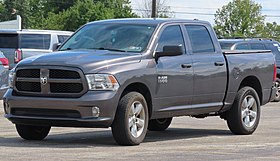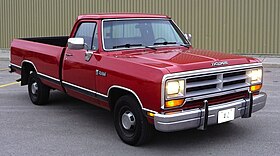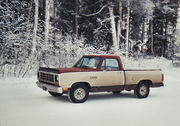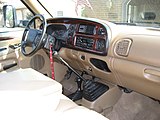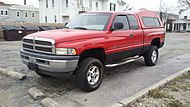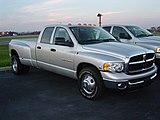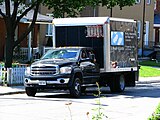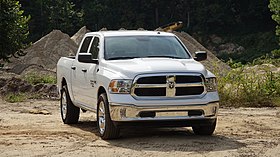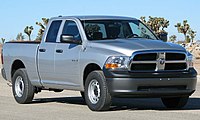|
Ram pickup
The Ram pickup (marketed as the Dodge Ram until 2010 when Ram Trucks was spun-off from Dodge) is a full-size pickup truck manufactured by Stellantis North America (formerly Chrysler Group LLC and FCA US LLC) and marketed from 2010 onwards under the Ram Trucks brand. The current fifth-generation Ram debuted at the 2018 North American International Auto Show in Detroit, Michigan, in January of that year. Previously, Ram was part of the Dodge line of light trucks. The Ram name was introduced in October 1980 for model year 1981, when the Dodge D series pickup trucks and B series vans were rebranded, though the company had used a ram's-head hood ornament on some trucks as early as 1933.[2] Ram trucks have been named Motor Trend magazine's Truck of the Year eight times; the second-generation Ram won the award in 1994, the third-generation Ram heavy-duty won the award in 2003, the fourth-generation Ram Heavy Duty won in 2010 and the fourth-generation Ram 1500 won in 2013 and 2014, and the current fifth-generation Ram pickup became the first truck in history to win the award four times, winning in 2019, 2020, 2021 and most recently, 2025. First generation (1981; D/W)
The first-generation Dodge Ram trucks and vans introduced in October 1980 feature a Ram hood ornament first used on Dodge vehicles from 1932 until 1954.[2] Not all of the first-generation trucks have this ornament and is most commonly seen on four-wheel-drive models. Dodge kept the previous generation's model designations: D or Ram indicate two-wheel drive while W or Power Ram indicate four-wheel drive. Just like Ford's F-Series, Dodge used "150" to indicate a half-ton truck, 250 for a three-quarter-ton truck, and 350 for a one-ton truck. The truck models were offered in standard cab, "Club" extended cab, and crew cab configurations. They also were offered along with 6.5 ft (2.0 m) and 8 ft (2.4 m) bed lengths and "Utiline" and "Sweptline" styled boxes along with standard boxes. Externally, the first-generation Rams were facelifted versions of the previous generation Dodge D-Series pickups introduced in 1972. The new model introduced larger wraparound tail lamps, dual rectangular headlamps, and squared-off body lines. Engine choices were pared down to the 225 slant-6 and 318 and 360 V8s. The interior was updated, included a new bench seat, a completely new dashboard and an instrument cluster with an optional three-pod design – a speedometer in the center, with the two side pods containing an ammeter on the top left, a temperature gauge on the bottom left, a fuel gauge on the top right and an oil pressure gauge bottom right. Models without the full gauge package had only indicator lights in the place of the temperature and oil pressure gauges. Among the options offered on the Ram were front bumper guards, a sliding rear cab window, air-conditioning, cruise control, tilt steering column, power door locks and windows, AM/FM stereo with a cassette tape player, styled road wheels, aluminum turbine-style mag wheels, special paint and stripe packages, two-tone paint, and a plow package for four-wheel-drive models (referred to as the "Sno Commander"). The "Club Cab" was dropped from the lineup after 1982, but Dodge kept the tooling and reintroduced it nearly a decade later in the 1990 models. The four-door crew cab and Utiline beds were dropped after the 1985 model year, to make room on the assembly line for the then-upcoming 1987 Dodge Dakota, and were never reintroduced in this generation. Basic Ram 100 models were reintroduced for 1984, replacing the previous "Miser" trim level available on the Ram 150. A "Ram-Trac" shift-on-the-fly transfer case was added for the 1985 Power Rams, and both the crew cab and Utiline flared bed versions were discontinued for 1986, the latter not to return on any Chrysler-built pickup. In 1988, the slant-6 engine was replaced by a 3.9 L (240 cu in) fuel-injected V6 engine first introduced with the Dodge Dakota. The 5.2 L (318 cu in) engine, on which the 3.9 L V6 is based, also received electronic fuel injection in 1988. Because of the new computer-controlled fuel injection, ignition, and ABS system, more vehicle information needed to be displayed through any warning or notification lights; so inside the cab where a small compartment was once located on the dash, a new "message center" with four small rectangular light spots, contained the check engine light and other tell-tales including one for the parking brake and the ABS if the truck was so equipped. The message center later included "wait to start" and "water in fuel" lights on diesel models. Diagnostic fault codes were stored in the computer's memory, and cycling the ignition key three times allowed the computer to flash the trouble codes through the check-engine light for diagnosis of some problems.[3] Rear ABS became standard equipment in 1989. The Ram 100 model designation was dropped and these models folded back into the 150 range for 1990, due to the introduction and sales success of the Dodge Dakota pickup. Additionally, the instrument cluster was slightly revised; the ammeter was replaced by a voltmeter while maintaining the 3-pod arrangement of the speedometer and gauges. Also for 1990, Dodge reintroduced the Club Cab, equipped with fold-out jump seats for the 1991–1993 models. Entry was made through the passenger or driver's doors because there were no rear doors for this configuration. For 1991, all versions received standard rear-wheel anti-lock brakes.[4] These trucks, though popular with fleets, sold poorly compared to the Ford F-Series and the General Motors C/K trucks, with sales rarely breaking 100,000 units for most years of their production. Part of this was due to the dated cab and chassis design which had been in production since 1972, the lack of a powerful diesel option until 1989, and the lack of a big-block gasoline V8 option. Additionally, the interior had been given few updates since the October 1980 market launch. Engines and transmissionsFor 1989, the 5.9 L V8 received throttle-body fuel injection for a 20 hp (15 kW) gain. Additionally, Dodge introduced a new overdrive automatic transmission for reduced fuel consumption. This light-duty transmission was designated the A500, and was offered with the 3.9 L V6 and 5.2 L V8. An "O/D off" pushbutton switch to lock out the overdrive 4th gear was added to the message center. The A727 automatic saw continued use for some 5.2 L engines, all 5.9 L engines, and heavy-duty applications. The grille was redesigned for 1991 but kept the large rectangular headlamps and crossbar appearance. The engines were substantially upgraded for 1992 (3.9 L and 5.2 L) and 1993 (5.9 L) with multi-port fuel injection, new manifolds, and higher-compression cylinder heads for noticeably higher output. These newly revised engines were marketed under the "Magnum" name. A heavy-duty automatic transmission with overdrive called the A518 was offered with the 5.2 L and 5.9 L engines. As part of Chrysler's overhaul of corporate transmission nomenclature, the A500 and A518 were redesignated 42RH and 46RH, respectively, in 1992. The initial 4 signified a 4-speed transmission, the second digit identified the transmission's relative torque capacity, the letter R in the third position denoted a rear-wheel-drive transmission, and the final letter H signified hydraulic shift control. The 3-speed automatic remained available; the A727 was redesignated 36RH, and the A904, A998, and A999 became the 30RH, 31RH, and 32RH, respectively. Cummins Turbo Diesel After 1978, the Chrysler RB engine was discontinued and therefore no longer offered in Dodge pickup trucks. Without a "big-block" gasoline engine or diesel, Dodge's heavier-duty models had a severe power disadvantage over the competition, and thus began losing potential customers in the commercial market. Rather than developing a brand-new engine, Chrysler signed a deal with commercial engine manufacturer Cummins to use a version of its 5.9L B Series engine in the Ram trucks. This proved to be a mutually beneficial deal, allowing Cummins to expand its product output and Dodge to have a competitive engine for its heavy-duty models.[5] The introduction of the Cummins Turbo Diesel model in 1989 coincided with the first sales increase for Ram trucks in several years. The Cummins was coupled with a heavier-duty version of the A727 automatic or a 5-speed manual transmission and was available on 250 and 350 pickups and pickup-based chassis-cab trucks above 8,500 pounds GVWR. This diesel engine option was different from the diesel engines offered in Ford and GM trucks in that the Cummins features direct injection, whereas the Ford and GM diesels feature indirect injection. This also means that the Cummins does not have to rely on glow plugs. The Cummins is a straight-six engine, whereas the GM and Ford diesel engines are V8 engines. Additionally, the Cummins is turbocharged, while the 6.2L GM/DDC and 7.3L IDI Ford/IH are naturally aspirated.[5] This was not actually the first engine to debut in Dodge pickup trucks as a diesel option. The 1978 D-series models were available with a Mitsubishi naturally-aspirated diesel, but it was seldom ordered.[5] The Cummins diesel was in short supply the first two years, but for 1991, Dodge managed to ramp up production.[4] Partway through the 1991 model year, Dodge started using 350 (one-ton) frames in Ram 250 Cummins and Club Cab models.[6] Engines
Special editions
Second generation (1994; BR/BE)
The second-generation Dodge Ram began development in 1986. The original concept, dubbed the "Louisville Slugger" by Chrysler's Advanced Packaging Studio, was to be a modular platform that would accommodate a full-size truck and full-size van, which would have provided a roomy cab and cargo bed.[9] The modular design was scrapped in 1987 and was replaced with a more conventional truck design when the design was moved to the American Motors design studio.[9] The more conventional design, dubbed "Phoenix", was originally scheduled for a 1991 production; when Bob Lutz showed it to the new styling designers, chief designer Phillip E. Payne told him, "It looks like nothing more than a rehash of everybody else's truck." At that, Lutz told him he had six months to come up with something better.[10] The exterior styling of the truck that was eventually released was the result of design concepts by Payne during 1988–1990. A review by the Dodge pick-up truck studio designers felt that modern pick-ups looked "too flat and sedan-like", while the early 1950s Studebaker pick-up and the semi-trailer trucks had just the right "macho" look to them.[11] The design included a big-rig-style front end and a large grille that was deemed risky at its introduction, but ultimately proved popular with consumers.[12] Debuted on January 5, 1993, at the North American International Auto Show and going on sale on October 1, 1993, the redesigned 1994 Ram was a sales success and was named "Truck of the Year" by Motor Trend in 1994.[13][12] Sales increased from 95,542 units in 1993 to 232,092 in 1994, 410,000 in 1995, and 411,000 by 1996. The latter third year, it was prominently shown as the hero vehicle in the film Twister, as well as the CBS television series Walker, Texas Ranger.[14][15][16][17] Sales of this generation peaked at just over 400,000 in 1999 before declining against the redesigned Ford and GM trucks. By 2001, Ram sales figures trailed those of Ford and GM trucks. The engine offerings were carried over from the last generation, which were the 3.9L V6, 5.2L V8, 5.9L V8, and 5.9L I6 Cummins turbo diesel options. Added to the lineup was a 300 hp (220 kW) 8.0L gasoline V10 designed as an alternative for those who wanted superior pulling power, but did not want a diesel (similar to GM's 7.4L V8), thus making the former the first factory V10 truck. The V10 and diesel were available in 2500/3500 models above 8,500 pounds GVWR. Models were now the 1500 half-ton, 2500 three-quarter-ton, and 3500 dual-rear-wheel only one-ton in both two- and four-wheel drive. Ram 1500s offered both short 6.5-foot (2.0 m) and long 8-foot (2.4 m) cargo beds on both regular and extended Club Cabs, Ram 2500s offered only long beds with regular cabs or a choice of beds on Club Cabs, and Ram 3500s only offered long beds on both cabs. Dodge offered the 2500 series in two different GVWRs (7,500 and 8,800 pounds) from 1994 to 1996. The purpose of the difference between the light-duty and heavy-duty 2500 trucks was for the heavy-duty 2500 to take the place of the discontinued one-ton single-rear-wheel trucks. Rear axles for the light-duty 2500 trucks were semi-floating, while the heavy-duty 2500 rear axles were full-floating. Light-duty 2500 trucks shared the frame with the 1500, were only available in regular cabs in two- or four-wheel drive, and were equipped with either the 5.2L or 5.9L V8 engine. All Ram 2500s and 3500s had eight-lug wheels. On the inside, special attention was paid to in-cab storage features, with a large glovebox, a center armrest storage area, and extra storage space behind the seat. 1998 updatesIn 1998, Dodge introduced the 4-door Quad Cab, which used smaller clamshell doors directly behind the main doors. This was the first extended cab pickup to have four doors (the 2-door Club Cab remained available through 2002). Other changes for 1998 included new rounded black plastic sideview mirrors, new plastic fold-out towing mirrors, a revised interior and instrument panel, dual airbags, a chime replacing the buzzer for seat belts/door ajar/headlights, and a digital odometer. The OBD-II system was also standard, with a computer port near the driver's-side footwell and a code-checking system via the new digital odometer readout. In late 1998, Dodge introduced a revised front end for the 1999 model year Sport models with a restyled bumper, quad-beam clear-lens headlamps, and body-color grille. A 6-speed manual transmission was made optional for diesel models in late 2000 for the 2001 model year. A small percentage of the diesel engines for the 1999 and 2000 model years were subject to problems with the water jackets and fuel injectors. The most problematic was the "53" stamped engine block which had a defect that would cause fracturing in the structure of the block itself. The 2000 models offered the option of heated leather seats. The braking system was upgraded to dual-piston calipers in the front. An Off-Road Edition was offered as a package with a 2-inch lift, accomplished with stiffer front springs and rear lift blocks, unique 17×8" wheels, 275/70/17 all-terrain tires, 4.10:1 rear axle ratio, trussed Dana 44 front axle, limited-slip differential, and skid plates.[18] The Off-Road Edition models are also distinguishable with an additional "Off Road" decal on the tailgate under the 4×4 decal. The 2000 model was cut short, ending production in January 2000 to avoid a CAFE requirement. After that, 2001 models began production.[19] While Dodge introduced a new Ram 1500 for 2002, the second-generation Ram was carried over for the 2002 heavy-duty 2500 and 3500 trucks. The new third-generation Ram would not debut in the 2500 or 3500 series until 2003. Part of this delay was due to the then-new 5.7 L Hemi engine not being ready for production. Mexico-only applicationsUnencumbered by CAFE (Corporate Average Fuel Economy) restrictions, DaimlerChrysler's Mexican subsidiary developed a three-door SUV version of the Ram, called the Ramcharger as was its predecessor. It debuted in 1998, but was never available in the United States.[20] There were also medium-duty Ram trucks that were only manufactured and marketed in Mexico.[21] DrivetrainTransmissionsRam transmissions are labeled such that the first number indicates the number of gears (including overdrive), the second number is the capacity rating, and the last letter is either E for electronic or H for hydraulic.[22]
The NV3500 was offered in 1500 and light-duty 2500 trucks. The NV4500 was standard in heavy-duty 2500 and 3500 trucks; the NV4500HD for V10 and diesel models. An NV5600 was offered in 1999 and 2000 Rams and was the only transmission offered behind the High Output diesel in 2001 and 2002. Transfer casesThere were a total of five transfer cases available for the four-wheel-drive Ram. All are part-time and have a low range of 2.72:1. The 1500 featured an NP231 and NP231HD. The NP241 was standard on V8 3500s. The 2500 and 3500 V10 and diesel featured an NP241DLD from 1993 until 1997. In 1997, the NP241DHD became an option for 2500s and was standard on 3500s from 1998 to 2002. AxlesThe Dodge Ram features a wide variety of axles. For the front axle of 4×4 Rams, a Dana 44 was used on all 1500s and the early (light-duty) 2500s. However, most of the 2500 and all 3500 Rams use Dana 60 front axles. The 1500s and some early light-duty 2500s used a 9.25 Chrysler (Spicer) axle in the rear. A Dana 60 rear axle was used on heavy-duty 2500s with the 5.9L V8. A Dana 70 rear axle was used in 2500s with a V10 or diesel and automatic transmission combination. A Dana 80 rear axle was used on 2500s with a manual transmission and V10 or diesel engine combination. Every 3500 was made with a Dana 80. The front-drive axles in 3500s were unique in the fact they did not have locking hubs, but featured a center axle disconnect. The 2002 2500s and 3500s saw the eventual phase-out of the center axle disconnect, in favor of front axles that were permanently locked in. Dodge continued to include front axles like this for its 2500 through 5500 trucks until the 2013 models. EnginesA natural-gas-powered engine debuted for the 1995 model year, but was not popular and was only used in fleet vehicles on a limited production run. The Cummins B Series engine was switched from the 12-valve to the 24-valve (ISB) version in the middle of the 1998 model-year Dodge Rams to comply with emissions regulations. The ISB featured a new computer-controlled electronic injection pump and a 24-valve head design.[24]
Special editions
Gallery
Third generation (2002; DR/DH/D1/DC/DM)
In development from 1996 (styling by Cliff Wilkins finalized in 1998), the third-generation Dodge Ram debuted on February 7, 2001, at the 2001 Chicago Auto Show.[31] Production later began for the 2002 model year on 1500 models, and 2003 on 2500 and 3500 models. This major update included an all-new frame, suspension, powertrains, interiors, and sheet metal. The crew cab models for this generation were actually Quad Cab trucks that had conventional-opening rear doors. The four-wheel-drive light trucks (1500 series) remove their beam axles in favor of an independent front suspension, but the 2500 and 3500 series retained the live axles for maximum longevity and durability; rear-wheel-drive 2500 and 3500 trucks had class-exclusive rack-and-pinion steering for their independent front suspension (the 1500 also received rack-and-pinion steering for the first time). This body style drew heavily from the previous generation. The redesigned trucks bolstered sales, with 400,000 sold during 2001–2002 and nearly 450,000 sold during 2002–2003, a new high point for the Ram name. At the same time, both Ford and GM trucks were increasing in sales from a 2001 peak of over 850,000 to the 900,000 range. However, with 400,543 Rams sold that year, the total did not keep up with the eleventh-generation F-150 in 2004. 2006 refresh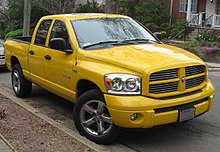 The entire lineup was updated for the 2006 model year. One notable addition was the "Mega Cab," featuring a 6.25-foot (2 m) cargo box and 22 inches (559 mm) of extra cab space, allowing seating for six with rear recliners. A full-screen-mapping in-dash navigation system became an option, and the front fascia was modernized. For 2006, the steering wheel design was changed to the same as seen in the Dodge Dakota and Dodge Durango. The Bluetooth Uconnect radio was now available as an option, and a facelift was given to all Ram models. SIRIUS Satellite Radio was available, as well as a rear-seat DVD entertainment system with wireless headphones. The high-performance SRT-10 was discontinued after the 2006 model year. For 2007, the taillights were slightly revised. For 2008, the RAM 1500 emblems on the front doors were replaced with RAM emblems. Chassis CabIn 2007, a 3500 Chassis Cab model was introduced with industry-standard rear frame width and wiring to accommodate outfitters. In addition to the 5.7 L (345 cu in) V8, a Cummins 6.7 L (408 cu in) diesel rated at 350 hp (261 kW) and 650 lb⋅ft (881 N⋅m) was available. Automatic transmissions used were the 545RFE with the 5.7 L (345 cu in) and the AS68RC with the 6.7 L (408 cu in). The G56 transmission was the only manual transmission offered. For 2008, Dodge introduced two more Chassis Cab models, the all-new 4500 and 5500 (to compete with Ford's F-450/F-550). These were Class 4 and Class 5 trucks with a gross weight rating of 16,500 lb (7,484 kg) and 19,500 lb (8,845 kg), respectively. Both trucks came equipped with the same version of the Cummins 6.7 L (408 cu in) diesel as the 3500 chassis-cab model. Sterling, who worked with Dodge in development, had their own version, called the Sterling Bullet with a unique grille. Sterling is a division of Freightliner Trucks which, like Dodge, was owned by the former DaimlerChrysler. Sterling Trucks was licensed to sell Dodge Ram 4500 series trucks as the Sterling Bullet. When the Sterling brand was phased out by Chrysler Corporation, the Bullet was discontinued. Engines
Models built after January 1, 2007, offered a new 6.7 L Cummins turbo diesel introduced as an option in 2500/3500 models replacing the 5.9 L. It produces 350 hp (261 kW) and 650 lb⋅ft (881 N⋅m). Unlike the 5.9 L, which was backed by the 4-speed 48RE transmission, the 6.7 L was equipped with the new 6-speed 68RFE transmission. 2005 was the last year for the first version of the 5.7 L (345 cu in) Hemi V8. 2006 half-ton models offered the Multi-Displacement System Hemi V8 engine that also became available in Chrysler and Dodge sedans. This engine featured the same performance but had a cylinder-deactivating feature enabled under light loads to increase fuel economy by 3 MPG city and 4 MPG highway. This new Hemi still delivered 345 hp (257 kW) and 375 lb⋅ft (508 N⋅m). AxlesFor the 2003 model year, AAM axles replaced the Dana Corp axles. In the front, all 2500 and 3500 trucks were 9.25-inch with 33 spline axles. The rear options for the 2500 and 3500 were the AAM Corporate 10.5" and 11.5". Rear-axle shafts are 30 spline. The rear 11.5" has a gear ratio "carrier split" at 3.73 and numerically higher, but the General Motors AAM axles used a different carrier spacing preventing the installation of a Chrysler carrier into some GM axles, but the GM carrier can be installed in the Chrysler axle if a ring gear spacer is installed. Strength is similar to their earlier Dana 70 and 80 counterparts. Direct comparisons are difficult as the axles are made with completely different metallurgy.
Special editions


Fourth generation (2009; DS)
The fourth-generation Dodge Ram was introduced at the 2008 North American International Auto Show in Detroit.[44] This generation was sold as the 2009 Dodge Ram 1500 starting in Fall 2008. The 2500 and 3500 pickups were added for 2010, and the 3500, 4500, and 5500 chassis cabs were added for 2011. In 2010, the Ram Trucks brand was separated from Dodge starting with the 2011 model year. Chrysler LLC attempted to keep the Ram competitive in the market through various developments for the 2009 model, including a new four-door cab style offering, new suspension, a new Hemi engine option, and the Rambox, a new storage system that allows secure storage inside the truck's bed walls. Later models have the Rambox system tied in with the remote keyless system.[45]  In 2010, Ram was separated from Dodge, and made a separate marque. This was supposedly done so Dodge could focus more on passenger and performance cars. Despite having split from Dodge in 2010, it was actually still marketed as one until the 2013 refresh.[46] From 2011 through 2018, Ram 2500/3500 models were marketed as having a "class-exclusive" manual transmission option, as General Motors and Ford had discontinued manual transmissions for North American models for 2007 and 2011 respectively. The Ram 1500 (2010–2018), Ram 1500 Classic (2019–2024), Ram 2500 through 5500, and Ram DX chassis cab (Mexican market) were assembled at Saltillo Truck Assembly Plant in Coahuila, Mexico. From 2009 to 2018, the Ram 1500 (DS) was assembled at Warren Truck Assembly in Warren, Michigan, and the 2009 Dodge Ram 1500 was also assembled at Saint Louis Assembly in Fenton, Missouri, until its closure in 2009. Cab and bed options The Ram was available with three bed lengths (5.5', 6.3', and 8') and four cab styles.[47] Regular cab models offered a 6.3' or 8' bed (with the former exclusive to the 1500), Quad Cab models were now exclusive to the 1500 and were only available with the 6.3' bed, and the all-new Crew Cab was available with the 5.5' (1500 only), 6.3', or 8' bed (2500/3500 only). The Mega Cab option was still available, but only remained on the heavy-duty models, and had a 6.3' bed. Improvements made from the previous generation meant the rear seats in the Mega Cab were now able to recline.[48] Dual rear wheels were available with long-wheelbase Ram 3500 pickups as well as the Ram 3500 Mega Cab. For 2013, the Crew Cab became available with the 6.3' bed. HandlingA coil spring five-link rear suspension replaces the leaf springs for the 1500. This was the first traditional full-size pickup truck with rear coil springs since the 1972 Chevrolet/GMC C10 and C20 (although the Chevrolet Avalanche, an SUV-based pickup truck, used rear coil springs). Payload capacitiesThe 2009 model's towing capacity was originally rated at 9,100 lb (4,128 kg) for 2WD Ram 1500 with regular cab, long-bed, 5.7 L (350 cu in) Hemi engine, 3.92 differential and 17-inch wheels, but the rating increased to 10,450 lb (4,740 kg) without changing the setup.[49] For the 2010 model, payload was increased by 50 lb (23 kg) to 1,900 lb (862 kg) for the regular cab 2WD model with the 3.7-liter V6 engine.[50] Towing capacity for the regular cab Ram 1500 with 3.21 differential is rated at 6,100 lb (2,767 kg) with 17-inch wheels and 5,900 lb (2,676 kg) with 19-inch wheels. Crew Cab and Quad Cab models are rated at 5,700 lb (2,585 kg) and 5,800 lb (2,631 kg) respectively. GCWRs are 11,000 lb (4,990 kg) for all Ram 1500s with 3.21 axles; max 15,500 lb (7,000 kg) for 2WD Ram 1500 with long bed, 5.7L Hemi engine, and 3.92:1 rear axle ratio. Heavy Duty Chassis Cab  Chassis Cab versions were available on 3500, 4500, and 5500 models. The 3500 Heavy Duty model debuted at the 2009 Chicago Auto Show for the 2011 model year. Engine choices include the 5.7 L (350 cu in) Hemi V8 rated at 383 bhp (286 kW) at 5,600 rpm and 542 N⋅m (400 lb⋅ft) at 4,000 rpm for Ram 3500, and the 6.7 L Cummins turbo diesel rated at 350 bhp (261 kW) at 3,013 rpm and 880 N⋅m (649 lb⋅ft) at 1,500 rpm for Ram 3500 (optional), 4500, and 5500. Late-model 2011 diesel trucks were uprated to 800 lb⋅ft (1,085 N⋅m) of torque. Transmission choices included a standard 6-speed manual or optional 6-speed Aisin automatic. Both transmissions support the power take-off option. The 3500 model has the regular or crew cab with single or dual rear wheels. Four cab-axle lengths (60, 84, 108, and 120 inches) for 4500/5500 or two cab-axle lengths (60 and 84 inches) for 3500, and three trim levels (ST, SLT, and Laramie). The Ram 3500 has three axle ratios (3.42, 3.73, and 4.10) and 17" wheels. Ram 4500/5500 has three axle ratios (4.10, 4.44, and 4.88) and 19.5-inch wheels. The 4500/5500 Rams rear axle is a Dana S 110. The front axle on 4×4 models is manufactured by Magna, while 2-wheel-drive models just have a solid, non-drive axle. Concept truckThe Ram concept truck "Long Hauler" from 2012 is mostly based on existing Ram truck parts. The powertrain, frame, and wheels are all components of the Ram 5500 Chassis Cab. It is a "Mega Cab" which is optional on the lighter Rams. The GCWR for this truck is 37,500 lb and the weight of the truck is 9,300 lb.[51] Model year changes2013 changesThe 1500 receives a minor restyling. It features a new front fascia, optional projector-beam halogen headlamps with LED turn signals/parking lamps, wheels, and interior, where the "DODGE" name was removed from the dashboard and replaced with "RAM". All models offered for 2012 continue to be available for 2013 with the addition of a new high-end trim, the Laramie Longhorn Limited. The base ST model also becomes the Tradesman model. Other trim levels for 2013 include Express, SLT, Big Horn, Lone Star, Sport, R/T, Laramie, and Laramie Longhorn. The RamBox cargo management system continues to be available on most models for 2013. 2013 models have revised engine and transmission options. The 3.7 L V6 is discontinued, and the 4.7 L V8 equipped with the 6-speed 65RFE automatic takes its place as the new base engine, still producing 310 bhp (231 kW; 314 PS) and 330 lb⋅ft (447 N⋅m). New to the lineup is Chrysler's corporate 3.6 L Pentastar V6, coupled to the new ZF 8-speed Torqueflite8 automatic. It achieves best-in-class fuel efficiency and makes 305 bhp (227 kW; 309 PS) and 269 lb⋅ft (365 N⋅m). The Pentastar/ZF 8-speed is optional. Due to a new electric power steering system, the 5.7 L (350 cu in) Hemi V8 no longer has a power steering pump, and gains 5 horsepower, now making 395 bhp (295 kW; 400 PS) and 410 lb⋅ft (556 N⋅m). It is still available with the 65RFE 6-speed automatic, with the new 8-speed Torqueflite8 automatic optional. Air suspension is optional for 2013 models, offering four ride height settings. Electronic stability control becomes standard on 2500 and 3500 models. For 2013, the Ram is also the first North American pickup truck to offer keyless ignition. New infotainment systems are available for the Ram 1500 for 2013:
3500The 2013 models move up to 18" standard wheels, with 18" forged Alcoa wheels as an option. 3500 models offer a High Output package for the diesel. The rear differential ring gear is increased from 11.5" to 11.8" on H.O. trucks. The 11.8 axle cover doubles as a heat sink. 4×4Ram installed the center axle disconnect (CAD) system into the 3500 4×4 models. Ram trucks did not have a CAD system until the 2014 models. Ram states this technology improves fuel economy by 1 MPG, although EPA fuel economy tests do not include trucks over 8,500 pounds GVWR. The 4×4 saw additional changes with the transfer case now being made by BorgWarner instead of New Venture Gear. High Fuel EfficiencyA new model offered for the 2013 Ram was the HFE (High Fuel Efficiency). Based on the SLT model, the HFE offered 18/25 MPG out of its Pentastar V6 engine and eight-speed TorqueFlite transmission. It was available only on the two-wheel-drive regular cab model with a 6.3-foot bed. Standard features included a 220-amp alternator and an 800-amp battery to assist with the start-stop system. A 3.21:1 rear axle ratio was also standard. 2014 changes An air suspension option became available on the rear of the 2014 model year 2500 and 3500 pickups. 1500 models added the option of an EcoDiesel V6. 2500 models now feature a coil spring suspension, instead of leaf springs. The cast iron, flex-fuel, 4.7L V8 Chrysler PowerTech engine was discontinued, ending Corsair engine production, leaving the Ram 1500 with two engine choices. The aluminum, flex-fuel 3.6L V6 Pentastar is now the base engine, along with the 8-speed Torque-Flite transmission. The 3.6L V6 was now available on Laramie and Longhorn trims.[52] The Ram heavy-duty series of trucks (2500, 3500, 4500, and 5500) received a new interior design and revised exterior styling from the Ram 1500, which was restyled in 2013. Also for 2014, the new Outdoorsman trim became available, particularly intended for buyers who hunt, fish, and camp. The Mossy Oak special edition (first available in 2012) also returned for 2014. 2016 changes For 2016, the all-new Ram 1500 Rebel debuted, offering off-road suspension with a 1.0 inch (2.5 cm) higher ride height, larger tires, and a unique interior to add to the Ram 1500 Big Horn and Lone Star trim levels. It features a unique blacked-out grille with powder coated front bumper and exclusive aluminum hood, skid plates, and tow hooks.[53] It is available with either a 305 hp (227 kW) and 269 lb⋅ft (365 N⋅m) 3.6L Pentastar VVT flex-fuel capable V6 engine or a 395 hp (295 kW) and 410 lb⋅ft (556 N⋅m) 5.7L Hemi V8 engine.[54] Four-wheel drive is available with either powertrain, but the two-wheel drive model is V8-only. The sole body configuration offered is a crew cab with a 5.5' bed.[53] SLT models of all Ram trucks now receive the Uconnect 5.0BT (RA2) touch-screen radio as standard equipment, adding steering wheel-mounted remote phone controls, Bluetooth hands-free calling and wireless audio streaming, SiriusXM Satellite Radio, a USB port, and 3.5 mm auxiliary input jack, Radio Data System (RDS), voice control, in-radio vehicle customization, and a full-color five-inch LCD touch-screen display. This was previously a $495.00 option on the Ram SLT. 2017 changesFor 2017, the Ram 1500 Laramie Longhorn and Limited trims received the new RAM front grille and "RAM" emblem across the rear tailgate that debuted on the 2016 RAM 1500 Rebel. The 3.0L EcoDiesel V6 turbodiesel engine, produced by VM Motori, was dropped in mid-2017 in response to emissions cheating allegations. The engine was reintroduced in early 2018, after being recertified by the EPA. The 1500 SLT model lost the Uconnect ACCESS 8.4 infotainment system (RA3) option, leaving the UConnect 5.0BT (RA2) radio as the only radio option. However, all Ram heavy-duty (2500, 3500, 4500, and 5500) SLT models still offered the Uconnect ACCESS 8.4 infotainment system (RA3) as an option. The Rebel trim level of the Ram 1500 gains the previously optional Uconnect ACCESS 8.4A infotainment system as standard equipment, as do the Big Horn and Lone Star trim levels. A Rebel Black Edition Package is available that adds black accents to the Rebel. The Laramie trim level of the Ram 1500, 2500, 3500, 4500, and 5500 gets a standard nine-speaker, 506-watt Alpine 7.1-channel surround-sound premium audio system as standard equipment. Three new special edition trim levels debut for 2017 for the Ram 1500 model:
There is also a new Off-Road Package available for all Ram 2500 models (aside from the Power Wagon trim level, which includes the package as standard equipment), and includes unique pickup bedside graphics, off-road suspension, front tow hooks, and the protection package. The mid-level SLT trim level of the Ram 1500 is no longer available to retail customers, as it is now a lesser-equipped model reserved exclusively for fleet customers. However, the SLT trim level still remains for the Ram 2500, 3500, 4500, and 5500 models, and is available to retail customers. However, retail customers wanting SLT features such as chrome front and rear bumpers and front grille, seventeen-inch aluminum-alloy wheels, power windows and door locks with keyless entry, the Uconnect 5.0BT (RA2) touch-screen radio, cloth seating surfaces, SiriusXM Satellite Radio, a rear-view backup camera system, and floor carpeting, can still opt for the Chrome Appearance and Popular Equipment Packages on the Tradesman model. A less expensive Bluetooth option for the Ram trucks is a new Uconnect 3.0BT (RA2) radio that includes an AM/FM radio and SiriusXM Satellite Radio tuner, Radio Data System (RDS), Uconnect Bluetooth hands-free phone system with audio streaming and voice command, steering wheel-mounted remote voice command controls, a USB port, and 3.5 mm auxiliary audio input jack, and a three-inch (3.0") monochrome LCD display screen. This radio option is available for the Tradesman trim level of all Ram trucks, and the Express trim level of the Ram 1500, and is included as part of a Popular Equipment Package on the latter model. Previously, customers wanting Bluetooth on a Ram Tradesman or Ram 1500 Express would have to upgrade to the Uconnect 5.0BT (RA2) touch-screen radio, which would add the same features as described above, as well as onscreen vehicle customization via the radio, and a full five-inch (5.0") color touch-screen display, and cost an additional $495.00. In order to do this, the customer would also have to select the Popular Equipment Package on both models. The Ram 2500 Power Wagon returned with a 6.4L Hemi gasoline V8 engine, a unique graphics package (delete option), black front grille, door handles, larger tires, and black aluminum-alloy wheels as well as the Off-Road Package. The Power Wagon Package is also available for the Ram 2500 Tradesman trim level, and also adds the 6.4L Hemi gasoline V8 engine. 2018 changesChanges to the Ram for 2018 included the addition of HD Radio to all Uconnect 8.4 infotainment systems, as well as a new 4G LTE wireless hot-spot provided by AT&T Wireless, an AT&T Wireless 4G LTE in-vehicle modem (both the AT&T Wireless 4G LTE modem and 4G LTE mobile hot-spot replace the Sprint 3G CDMA modem and 3G CDMA mobile hot-spot offered on previous Ram models), Apple CarPlay and Android Auto smartphone integration for the Uconnect 8.4 infotainment systems, and the SiriusXM Guardian service replacing the Uconnect ACCESS service offered on previous RAM models for the Uconnect 8.4 infotainment systems. In addition, all Uconnect 8.4 infotainment systems get a new user interface design for easier navigation of menus and applications. The VM Motori–produced 3.0L EcoDiesel V6 turbodiesel engine returned in early 2018 for the RAM 1500, as it has been re-certified by the EPA after allegations of emissions cheating in 2017. Most upper trim levels of the RAM 1500 (Sport, Rebel, Laramie Longhorn, and Limited) get the new RAM front grille introduced for 2016, as well as a large 'RAM' emblem on the rear tailgate. Lower to mid-trim levels of the RAM 1500 (Tradesman, Express, Big Horn, Lone Star, and Laramie) retain the standard RAM "Cross-Hair" front grille. The Night Edition and Lone Star Silver Edition trim levels were continued. For 2018, there are two new special editions:
2019 changes For 2019, the current fourth-generation Ram 1500 continued to be produced alongside its successor, the fifth-generation Ram 1500. Virtually identical to 2018 models, 2019 trucks were given a new name, the Ram 1500 Classic, to distinguish them from their all-new fifth-generation successors. The Ram 1500 Classic offers a 2-door Regular Cab model, which the fifth-generation Ram 1500 does not. In addition, Quad and Crew Cab models are also offered. In addition, the current-generation Ram 2500, Ram 3500, and Ram 3500/4500/5500 Chassis Cab models were redesigned for the 2019 model year.[55] In addition to a totally new front clip, the 2019 Ram 2500 and 3500 received new frames and updated interiors that borrowed heavily from the new DT 1500 interior. The Hemi 5.7L engine was dropped (except only Mexico-market Ram 4000), and the Hemi 6.4L becomes the base engine. For 2500 and 3500 pickups with the 6.4L, a ZF 8HP75-LCV 8-speed automatic is mated. The 6.7-liter Cummins turbo-diesel returns in both Standard and High-Output form, but with a new compacted graphite iron (CGI) block. Only automatic transmissions are available (except on Mexico-market Ram 4000). 2020 changesTradesman, Express, SLT (fleet only), Warlock, Big Horn, and Laramie trims are available.[56] A Black Appearance Package becomes available for the Warlock trim, which adds 20-inch black-finished aluminum-alloy wheels, and other black accents to the exterior of the truck. Flex-fuel capability in the V6 engine was removed. 2021 changesFor 2021, the Ram 1500 Classic Warlock trim receives an Off-Road Package, which includes all-terrain tires, as well as unique aluminum-alloy wheels. Base Tradesman and Express trims receive a newly available Infotainment Package, which includes the Uconnect 4C 8.4-inch touchscreen infotainment system, SiriusXM Satellite Radio, HD Radio, and Apple CarPlay and Android Auto smartphone integration. The base Uconnect 3.0 and Uconnect 3.0BT radios are discontinued, as the Uconnect 3 5.0BT touchscreen radio becomes standard equipment on all models, also adding the Uconnect Bluetooth hands-free phone system with audio streaming and steering wheel-mounted phone controls as standard equipment on all models. 2022 changesFor 2022, all Ram 1500 Classic models receive an optional upgraded Uconnect 5 8.4-inch touchscreen infotainment system, which now includes wired and wireless Apple CarPlay and Android Auto smartphone integration, as well as a new Android operating system. The older Uconnect 4C GPS navigation radio, as well as the Uconnect 3 5.0BT touchscreen radio, both remain available. 2023 changesFor 2023, the regular cab short bed configuration and Express trim were dropped. Newly optional on both models (Tradesman and Warlock) is the new Uconnect 5 infotainment system with an 8.4-inch touchscreen display, featuring wired and wireless Apple CarPlay and Android Auto smartphone integration as part of the Electronics Group. Both models still include the Uconnect 3 5.0BT touchscreen radio as standard equipment, and buyers can also still opt for the older Uconnect 4C 8.4-inch touchscreen GPS navigation and infotainment system. 2024 changesFor 2024, the EcoDiesel option was dropped. In addition, all versions come standard with a tailgate ajar warning; the Warlock package returned for the Tradesman trim which comes with black exterior trim, rear-locking differential, 1-inch raised suspension, performance-tuned shocks, and off-road gear, such as 33-inch tires, skid plates, and Bilstein front and rear performance-tuned shock absorbers. Engines
Plug-in hybridA two-mode hybrid version was planned to begin production in 2010, but Chrysler decided to cancel it in favor of a smaller test fleet of 140 plug-in hybrid (PHEV) Rams developed with support from a US$48 million grant from the U.S. Department of Energy financed through the American Recovery and Reinvestment Act of 2009. The Chrysler PHEV pickup project has an estimated total cost of US$97.4 million.[57][58] The RAM 1500 pickup PHEV was introduced at the January 2011 Washington Auto Show. The vehicle is part of a three-year demonstration program intended to field test and evaluate battery performance across a wide range of drive cycles and temperature ambients, and also to evaluate customer acceptance.[59] The PHEV demonstrator pick-up trucks are assembled at the Warren Truck Assembly plant in Michigan and the plug-in hybrid conversion takes place at the Chrysler Technology Center in Auburn Hills, Michigan. The demonstrators are being allocated for field testing among local and state governments, utility companies, and a US Army base.[60] Chrysler has no plans for a production version.[61]  The Ram 1500 PHEV demonstrator has a 345 hp 5.7 L (350 cu in) Hemi V8 gasoline engine mated to a two-mode hybrid transmission and a 12.9 kWh 355V lithium-ion battery from Electrovaya. This setup allows an all-electric range of more than 20 mi (32 km), but as a blended plug-in hybrid, the RAM PHEV does not run exclusively all-electric during EV mode. The fully charged plug-in starts off with charge depletion with limited regeneration at the high end of the state of charge (SoC). That ramps up to a full regenerative capability somewhere in the 70 to 95% range and depletes down to about 20%. Once depleted, it comes into a narrow charge-sustaining range.[57][59][60] The plug-in pick-up meets AT-PZEV emissions standards, making it the only full-size V8 pickup with an AT-PZEV rating. Its fuel economy in charge-depleting mode is more than 32 mpg‑US (7.4 L/100 km; 38 mpg‑imp) in city driving.[57][60] The Ram 1500 PHEV is capable of towing up to 6,000 lb (2,722 kg).[60] The first 20 Ram PHEV demonstrators were delivered in May 2011 to Clark County, Nevada and Yuma, Arizona, with 10 units each city.[57] Other cities that received the demonstration PHEVs are San Francisco and Sacramento, California, Albany, New York, and Charlotte, North Carolina. In September 2011, another 10 units were delivered to the Massachusetts Bay Transportation Authority (MBTA). Another 5 units were delivered to Central Hudson Gas & Electric and National Grid.[61] DTE Energy in Detroit was scheduled to receive 10 Ram PHEVs.[62] Special editions
IssuesFire incident, Hybrid, 2012In September 2012, Chrysler temporarily suspended the demonstration program. All 109 Ram 1500 Plug-in Hybrids and 23 Chrysler Town & Country plug-in hybrids deployed by the program were recalled due to damage sustained by three separate pickup trucks when their 12.9 kWh battery packs overheated. The carmaker plans to upgrade the battery packs with cells that use a different lithium-ion chemistry before the vehicles go back into service. Chrysler explained that no one was injured from any of the incidents, and the vehicles were not occupied at the time, nor any of the minivans were involved in any incident, but they were withdrawn as a precaution. The demonstration is a program jointly funded by Chrysler and the U.S. Department of Energy that includes the first-ever factory-produced vehicles capable of reverse power flow. The experimental system would allow fleet operators to use their plug-in hybrids to supply electricity for a building during a power outage, reduce power usage when electric rates are high or even sell electricity back to their utility company.[66][67] The company reported that the demonstration fleet had collectively accumulated 1.3 million miles (2.1 million km) before the vehicles were recalled. Chrysler also reported that the plug-in pickups delivered peak average fuel economy of 37.4 mpg‑US (6.29 L/100 km; 44.9 mpg‑imp), while the plug-in hybrid minivans delivered 55.0 mpg‑US (4.28 L/100 km; 66.1 mpg‑imp).[66] Remote Control, Software, Uconnect Entertainment System, 2015Charlie Miller, security researcher for Twitter and former NSA hacker, and Chris Valasek, director of vehicle security research at the consultancy IOActive, showed how a Jeep Cherokee can be remote controlled. FCA recalled 1.4 million vehicles with the Uconnect entertainment system on board.[68] SafetyThe Ram comes standard with four-wheel anti-lock disc brakes, side curtain airbags, and an electronic stability program or ESP. In Insurance Institute for Highway Safety (IIHS) crash tests, the 2009 Ram received a Good overall score in the frontal crash test, and a Marginal score in the side impact test,[69] as well as the roof strength test.[70]
It received a 5-star frontal crash test rating from the NHTSA,[73] however under later testing methods it received an overall 3-star rating.[74] In the side-pole test it was given a single star rating, because of excessive forces to the thoracic region. While the Ram 1500 features standard side-curtain airbags it does not include side torso airbags. The vehicle was redesigned and retested, and received a 5-star rating.
Gallery
Fifth generation (2019; DT)
 The fifth-generation Ram made its debut at the 2018 North American International Auto Show in Detroit, Michigan, on January 15, 2018,[80] while its HD version made its debut at the next year's show on January 14, 2019.[81] 2019 Ram 1500 sales began the first quarter of 2018 as an early 2019 model year vehicle.[82] The 2019 Ram 1500 pickup truck offered just seven trim levels, compared to the previous 11 different trim levels.[83] Ram added eTorque to the 2019 Ram 1500 as an option. eTorque combined a belt-drive generator with a battery pack to provide short-term torque and energy regeneration to increase torque output by up to 130 pound-feet (176 N⋅m) to the 5.7-liter Hemi. Also introduced in 2019 was the new Uconnect platform sporting a 12-inch touchscreen display, the largest in its class.[84]  The 2019 Ram 1500 saw increases in capability for this new model year with payload increasing to 2,300 pounds (1,000 kg) and maximum trailer towing capacity reaching 12,750 pounds (5,780 kg) when properly equipped. This pairs with a total weight reduction of about 225 pounds (102 kg) compared to the previous generation.[84] For the 2025 model year, the Ram 1500 received a mid-cycle refresh, and the Hemi V8 engine was discontinued in favor of the 3.0L Hurricane turbocharged inline-six engine. Concept vehiclesRevolutionThe Ram Revolution is Ram's first all-electric concept pickup truck. Featured for the 2024 model year, the Revolution is a body-on-frame design, with two motors providing all-wheel drive. As of January 2023, Ram has not provided any motor specifications other than stating that 100 miles of charge can be achieved within 10 minutes at a Level 3 DC fast-charging station.[85] World marketsIn 2022, Ram trucks were available in the United States, Canada, Mexico, Brazil, Colombia, Argentina, Chile, Paraguay, Peru, Europe, the Philippines, and the Middle East.[86] The Ram trucks officially sold in many Latin American countries are outfitted with UNECE WP.29 lighting equipment, including the taillights with separate amber turn signal indicators.[87] No right-hand-drive version has been built for the Australia, New Zealand, United Kingdom, South Africa, and other countries where the rule of the road is on the left. In 2016, FCA via the Ateco commenced selling the Ram 2500 and 3500 in Australia and New Zealand and the Ram 1500 in 2018. These are converted to right-hand drive in Australia before the sale. Pricing commences from $80,000AUD (approximately US$54,000 as of 28/08/19) for the 1500. Production of the Ram 1500 at the Warren Truck Assembly plant outside of Detroit was discontinued in 2024.[88] Ram trucks are provided for the European market in cooperation with FCA by AEC Europe in Germany and the Swiss company AutoGlobal Trade. Germany and Scandinavian countries are some of the largest European markets for the Ram. A thriving gray market exists in Australia, New Zealand, and the United Kingdom that has imported and converted Ram trucks to right-hand-drive and to meet the local regulations, being more common in Australia since LHD cars less than 30 years old (or 15 years old if registered in Western Australia) cannot be legally driven on Australian public roads unless they are granted a diplomatic or a research and development exception to the rule. In the United Kingdom and Japan, there is no such restriction, so a stock LHD Ram (or any other LHD vehicle) is not required to undergo the costly and time-consuming process of an RHD conversion in order to be compliant with EU regulations. Gray market import gallery
Nissan TitanFollowing the collapse of Nissan Titan sales in 2008, there were talks[89] that the next generation of Nissan's full-sized pickup would be outsourced to Chrysler as a version of the Ram 1500.[90] Nissan had been planning to phase out Titan production in its Canton, Mississippi factory in 2010 with the new Nissan-only design for a cab, body and interior riding on the Dodge Ram chassis assembled in Chrysler's truck assembly lines in Saltillo, Mexico.[91] However, the deal to build Nissan Titan pickups utilizing the full-sized Dodge Ram pickup starting in 2011 was delayed with the changes at Chrysler and Fiat.[92] Nissan eventually decided to keep the Titan,[93] and went on to release the second generation Titan as a 2016 model. Special editions
MotorsportDodge Ram NASCAR trucks in 2008 Lance Norick #90 L&R Racing Dodge in 1998 The Ram Pickup represented both the Dodge and Ram brands in the NASCAR Camping World Truck Series from 1995 to 2016, having won the Manufacturer's Championship in 2001, 2003, and 2004. The Ram Pickup also won the San Felipe 250 in 2008 and 2009. Sales
Notes
References
External linksWikimedia Commons has media related to Dodge Ram. Information related to Ram pickup |
|||||||||||||||||||||||||||||||||||||||||||||||||||||||||||||||||||||||||||||||||||||||||||||||||||||||||||||||||||||||||||||||||||||||||||||||||||||||||||||||||||||||||||||||||||||||||||||||||||||||||||||||||||||||||||||||||||||||||||||||||||||||||||||||||||||||||||||||||||||||||||||||||||||||||||||||||||||||||||||||||||||||||||||||||||||||||||||||||||||||||||||||||||||||||||||||||||||||||||||||||||||||||||||||||||||||||||||||||||||||||||||||||||||||||||||||||||||||||||||||||||||||||||||||||||||||||||||||||||||||||||||||||||||||||||||||||||||||||||||||||||||||||||||||||||||||||||||||||||||||||||||||||||||||||||||||||||||||
